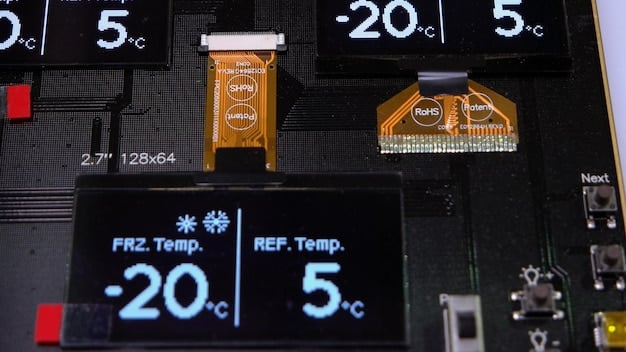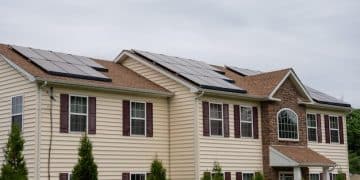Home Energy Storage Battery Lifespan in the US: Factors & Tips

The expected lifespan of a home energy storage battery in the US typically ranges from 5 to 15 years, influenced by factors like battery type, usage patterns, and maintenance practices.
Considering a home energy storage battery in the US? Understanding the lifespan of these batteries is crucial. Let’s explore what impacts their longevity and how to maximize it.
Understanding the Basics of Home Energy Storage Batteries
Home energy storage batteries are becoming increasingly popular in the US, offering homeowners a way to store excess solar energy, reduce reliance on the grid, and ensure backup power during outages. To truly harness their benefits, though, it’s important to understand how long these batteries are expected to last.
These batteries, often lithium-ion, are designed to cycle – charge and discharge – a certain number of times before their performance begins to degrade significantly. This degradation is normal and occurs over time, but knowing the factors that influence battery life can help you make informed decisions and potentially extend the life of your investment.
Types of Home Energy Storage Batteries
Different battery chemistries exist for home energy storage, each with its own lifespan characteristics:
- Lithium-ion (Li-ion): The most common type, known for its high energy density, relatively long lifespan, and good performance.
- Lead-acid: A more traditional option, generally less expensive but with a shorter lifespan and lower energy density compared to lithium-ion.
- Nickel-based: Less common in residential applications but offer good lifespan and temperature tolerance.
Choosing the right battery type depends on your budget, energy needs, and desired lifespan, but lithium-ion batteries dominate the residential market due to their favorable balance of performance and longevity.
Ultimately, understanding the basic types of home energy storage batteries provides a foundation for evaluating their expected lifespan and associated factors.
Key Factors Affecting Battery Lifespan

Various factors influence how long a home energy storage battery will last. Understanding these factors is essential for maximizing the battery’s lifespan and getting the most out of your investment.
The battery’s lifespan is not simply a matter of years; it’s a complex interplay of usage, environmental conditions, and maintenance practices. By managing these factors effectively, homeowners can optimize the performance and longevity of their energy storage systems.
Depth of Discharge (DoD)
DoD refers to the percentage of the battery’s capacity that is used before it’s recharged. Shallower discharges generally prolong battery life.
Cycle Life
The number of complete charge and discharge cycles a battery can handle before its capacity drops to a specified level (typically 80% of its original capacity). Deeper discharges reduce cycle life, while shallower discharges extend it.
- Consistent Deep Cycling: Regularly draining the battery to near-empty will significantly shorten its lifespan.
- Shallow Discharges: Using only a portion of the battery’s capacity before recharging can extend its life considerably.
- Manufacturer Specifications: Always refer to the manufacturer’s guidelines for optimal DoD to maximize battery lifespan.
In conclusion, awareness of DoD and its impact on cycle life is critical for promoting battery health and ensuring long-term performance.
The Impact of Environmental Conditions
Environmental conditions play a significant role in determining the lifespan of a home energy storage battery. Temperature, in particular, can have a substantial impact on battery performance and longevity.
Extreme temperatures, both hot and cold, can accelerate battery degradation. Proper installation and environmental control are crucial for maintaining optimal battery health.
Temperature Fluctuations
Excessive heat can cause the battery’s internal components to degrade more quickly, while extreme cold can reduce its capacity and charging efficiency. Batteries installed in garages or outdoor locations are more susceptible to such variations.
- Ideal Temperature Range: Most batteries function best within a temperature range of 15°C to 25°C (59°F to 77°F).
- Temperature Management: Consider installing the battery in a climate-controlled environment to minimize temperature fluctuations.
- Ventilation: Ensure adequate ventilation around the battery to dissipate heat and prevent overheating.
Taking environmental factors into account is critical for maximizing the lifespan and efficiency of home energy storage batteries in various climates.
Maintenance Tips for Extending Battery Life

Proper maintenance is crucial for extending the lifespan of a home energy storage battery in the US. Regular checks and proactive measures can help you identify potential issues early and prevent significant degradation.
By following these maintenance tips, homeowners can optimize the performance and longevity of their energy storage systems, ensuring a reliable and cost-effective investment.
Regular Inspections
Visually inspect the battery and its connections regularly. Look for signs of corrosion, damage, or loose wiring.
Software Updates
Keep the battery’s software up to date. Manufacturers often release updates that improve performance and optimize battery management.
Professional Servicing
Schedule periodic professional servicing to ensure the battery is functioning correctly and to address any potential issues before they escalate.
In summary, consistent maintenance practices are vital for safeguarding battery health and promoting reliable long-term performance.
Warranty Considerations
Understanding the warranty that comes with your home energy storage battery is paramount. A good warranty can provide peace of mind and financial protection in case of premature failure or performance degradation.
Warranties vary in their coverage and duration, so it’s important to carefully review the terms and conditions before making a purchase. Key aspects to consider include the length of the warranty, the covered components, and the performance guarantees.
Types of Warranties
There are generally two types of warranties associated with home energy storage batteries:
- Product Warranty: Covers defects in materials and workmanship.
- Performance Warranty: Guarantees that the battery will maintain a certain percentage of its original capacity over a specified period.
Key Warranty Terms
Be sure to understand the following key terms:
- Warranty Period: The duration of the warranty coverage.
- Capacity Retention Guarantee: The minimum percentage of original capacity the battery is guaranteed to retain over time.
- Exclusions: Conditions or events that are not covered by the warranty, such as improper installation or environmental damage.
In conclusion, analyzing warranty terms and conditions is essential for securing your investment and mitigating potential risks associated with battery performance.
Cost Implications of Battery Lifespan
Battery lifespan directly impacts the overall cost-effectiveness of home energy storage systems in the US. A longer lifespan translates to lower long-term costs, while a shorter lifespan can result in increased expenses due to more frequent replacements.
Consider the total cost of ownership, including the initial purchase price, installation costs, maintenance expenses, and potential replacement costs. By maximizing battery lifespan, homeowners can achieve a greater return on their investment.
Long-Term Savings
A longer-lasting battery reduces the need for replacements, saving homeowners money on the cost of new batteries and installation expenses.
Return on Investment (ROI)
Extending battery lifespan improves the ROI of the energy storage system by maximizing the amount of energy stored and used over the battery’s lifetime.
Financial Planning
When evaluating home energy storage options, consider the projected lifespan and potential replacement costs to accurately assess the long-term financial implications.
Ultimately, recognizing the cost implications associated with battery lifespan is critical for making informed decisions and optimizing the financial benefits of home energy storage.
| Key Point | Brief Description |
|---|---|
| 🔋 Battery Type | Lithium-ion batteries generally last longer than lead-acid options. |
| 🌡️ Temperature | Extreme temperatures can significantly reduce battery lifespan. |
| 🔄 Depth of Discharge | Shallower discharges help extend battery life. |
| 🛠️ Maintenance | Regular inspections and software updates can improve battery lifespan. |
Frequently Asked Questions (FAQ)
▼
Home energy storage batteries usually last between 5 to 15 years, depending on battery type, usage, and maintenance.
▼
Lithium-ion batteries are generally favored due to their high energy density and relatively long lifespans compared to lead-acid options.
▼
Extreme temperatures, both hot and cold, can accelerate battery degradation and shorten its overall lifespan. Maintaining a stable temperature helps.
▼
Regular inspections, software updates, and occasional professional servicing can significantly extend the lifespan and performance of your home battery system.
▼
Consider the warranty period, capacity retention guarantee, and any exclusions, ensuring it provides sufficient coverage for your investment.
Conclusion
Understanding the factors that influence the lifespan of your what is the expected lifespan of a home energy storage battery in the US? Factors and maintenance tips – from battery type and environmental conditions to usage habits and maintenance – is crucial. By implementing the strategies discussed, homeowners can maximize their battery’s life and enjoy the benefits of reliable, sustainable energy storage for years to come.





